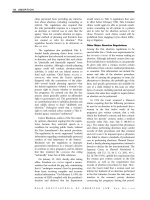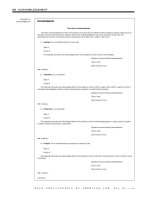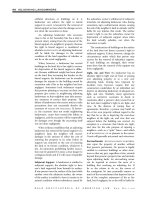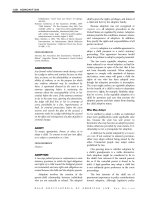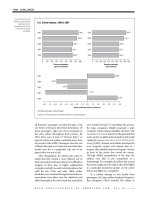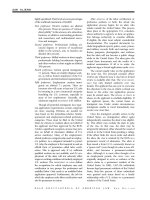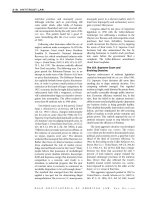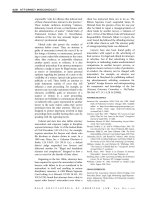Gale Encyclopedia Of American Law 3Rd Edition Volume 2 P25 pot
Bạn đang xem bản rút gọn của tài liệu. Xem và tải ngay bản đầy đủ của tài liệu tại đây (609.75 KB, 10 trang )
regardless of whether defendants wanted it.
Moreover, the burden of showing how cameras
have a prejudicial effect on a given trial would
fall on the defendant. Chief Justice Warren E.
Burger’s majority opinion cautioned, “Dangers
lurk in this, as in most experiments, but unless we
were to conclude that television coverage under
all conditions is prohibited by the Constitution,
the states must be free to experiment.”
The freedom to experiment brought cameras
firmly into state courts. The ABA abandoned its
prohibitive stance, and more states began con-
ducting experiments of their own. The launch on
July 1, 1991, of Court TV, a cable channel that
provided televised trial coverage of newsworthy
cases, sought to further legitimatize the use of
cameras in the courtroom. By 1995, 47 states
permitted some form of televising of state trials.
But in 1994, the federal court system chose
otherwise. The federal
JUDICIAL CONFERENCE OF THE
UNITED STATES
authorized a three-year experiment
in 1991 that permitted camera coverage of
federal civil trials. Most judges who participated
in the experiment, which involved six trial court
districts and two appellate districts, viewed the
experience favorably; in fact, a report prepared
by the Judicial Conference recommended
extending camera coverage to all federal district
and appellate courts. But in 1994 the confer-
ence voted to end the experiment without
explanation. Many advocates of televising
federal trials blamed this decision on the
excessive publicity from the 1994 pretrial
hearings in the case of
O. J. SIMPSON, a popular
sports and entertainment personality who was
accused and later acquitted of murdering his
former wife Nicole Brown Simpson and her
friend Ronald Lyle Goldman.
By the beginning of the twenty-first century,
all 50 states allowed some level of camera
presence in their courts (only the District of
Columbia prohibited cameras in trial and
appellate proceedings), but the rules governing
when and where cameras are allowed varied
enormously. In N ew York, for example, cam-
eras have been banned from criminal trials since
1952 under Section 52 of the state’s
CIVIL RIGHTS
Law. A 2001 challenge to the law by Court TV
argued that Section 52 was unconstitutional
because it violates the
FIRST AMENDMENT.Butin
2003 Manhattan Supreme Court Justice Shirley
Werner Kornreich upheld the ban on cameras,
noting that televising trials could disrupt the
proceedings enough to have an impact on the
fairness of those trials.
During the early 2000s, several proposa ls
were introduced that would permit cameras
during federal trials. However, opposition to
these proposals has been strong, and as of 2009,
none of the proposals had passed.
The U.S. Supreme Court does not allow
cameras in its proceedings; transcripts are made
available, but not immediately. In a move that
surprised many, the Court allowed the release of
audiotapes of its proceedings in the Florida
presidential election results late in 2000. The
Court deemed those hearings to be important
enough to warrant a special dispensation of its
normal procedures. In 2003 the Court again
allowed audiotapes to be released in the
University of Michigan Law School
AFFIRMATIVE
ACTION
case, as well as the hearings on the
constitutionality of the McCain-Feingold cam-
paign finance reform law. The Court has
emphasized that such access will only be allowed
in rare instances and only for cases it deems
crucial enough. As for televised Supreme Court
proceedings, Chief Justice
WILLIAM REHNQUIST
wrote to Senator Arlen Specter of Pennsylvania,
a proponent of television coverage, that “a
majority [of the Justices] are of the view that it
would be unwise to depart from our current
practice.” Rehnquist has stated that he would not
allow camera coverage if even one justice was
opposed.
The sensational 1934
trial of Bruno
Hauptmann (center)
for the Lindbergh
kidnapping created
such a disruption that
cameras were banned
from nearly all
U.S. courtrooms
in 1937.
AP IMAGES
GALE ENCYCLOPEDIA OF AMERICAN LAW, 3
RD E DITION
228 CAMERAS IN COURT
FURTHER READINGS
“Are We Being Fed a Steady Diet of Tabloid Television?”
1994. ABA Journal (May).
Caher, John M. 2003. “Court TV Effort to End Camera Ban
Sparks Debate on Civil Rights Law.” New York Law
Journal 229 (April 23).
“Cameras in the Courtroom: Should Judges Permit High-
Profile Trials to Be Televised?” 1995. American Bar
Association Journal (September).
Fong, Liz. 2002. “Judges Restrict Camera Access in Court-
rooms.” News Media & the Law 26 (fall): 12.
“Mass Media’s Impact on Litigation, Lawyers, and Judges.”
1995. Review of Litigation (February 24).
Moyer, Bruce. 2000. “House OKs Court Improvements and
Cameras in Court.” Federal Lawyer 47 (July): 12–13.
“Senate Passes Cameras-in-Court Bill.” 2001. Associated
Press (November 30).
“That’s E ntertainment! The Continu ing Debate over
Cameras in the Courtroom.” 1995. Federal Lawyer
(July).
CROSS REFERENCES
Courtroom Television Network; Criminal Procedure;
Freedom of the Press; Lindbergh Kidnapping
CAMPAIGN FINANCE REFORM
See ELECTION CAMPAIGN FINANCING.
v
CAMPBELL, BEN NIGHTHORSE
In 1992, BEN NIGHTHORSE CAMPBELL, a rancher,
teacher, judo champion, and jewelry designer
became the first Native American to serve in
theU.S.Senateinmorethan60years.
Campbell was born April 13, 1933, in
Auburn, California, the son of Albert Valdez
Campbell, who was part Northern Cheyenne
Indian, and Mary Vierra, a Portuguese immi-
grant. His mother was a patient and occasional
employee at a tuberculosis sanitorium when she
met his father, who also worked there. They were
married in 1929 and had two children, Campbell
and his sister, Alberta Campbell, who died at the
age of 44, an apparent suicide.
Campbell’s father was an alcoholic who
frequently disappeared, leaving Campbell’s
mother to support and care for the children.
Campbell and his sister spent time in orpha-
nages and foster homes when their mother was
too sick to work and provide for them.
Eventually, his father was able to work and
the family opened a small grocery store, which
prospered later when a freeway was built with
an exit ramp at the location of the store.
When Campbell entered high school he had
little sense of enthusiasm or direction concerning
his education. In 1950 he dropped out and
joined the U.S. Air Force. He served in the
KOREAN WAR and was discharged from the service
with the rank of airman, second class. He passed
the high school equivalency test to receive
his general equivalency diploma, and in 1957
Ben Nighthorse Campbell 1933–
▼▼
▼▼
1930
2000
1975
1950
◆
◆
◆◆◆◆◆◆◆◆◆
◆
❖
1961–73
Vietnam War
1950–53
Korean War
1939–45
World War II
1933 Born,
Auburn, Calif.
1950 Dropped
out of high
school; joined
U.S. Air Force
1957 Earned
B.A. from
San Jose
State
1964 Served as
captain of U.S.
Olympic Judo
Team at Tokyo
Olympic Games
1963 Won gold medal at
Pan-American Games
1980 Enrolled as
official member of
Black Horse family
and Northern
Cheyenne tribe
1986
Elected
to U.S.
House of
Representatives
1982 Elected to Colo. Legislature
1992 Elected to U.S. Senate; first
Native American senator since 1929
2003 Named
Senate Deputy
Majority Whip
2004 Announced resignation from Senate;
returned to private practice
1998 Became first Native
American to chair the Senate
Committee on Indian Affairs
1995 Switched
his political
affiliation from
Democrat
to Republican
Ben Nighthorse
Campbell.
AP IMAGES
MY GRANDFATHER
TOLD ME THAT AT THE
LITTLE BIG HORN
CUSTER DROPPED
THE FLAG AND THE
CHEYENNES PICKED IT
UP
… NOW THE
FLAG UNITES ALL OF
US IN THIS GREAT
COUNTRY
.
—BEN CAMPBELL
GALE ENCYCLOPEDIA OF AMERICAN LAW, 3RD E DITION
CAMPBELL, BEN NIGHTHORSE 229
graduated from San Jose State University with
a bachelor’sdegreeinphysicaleducationand
fine arts.
When he was a teenager Campbell became
interested in judo and it became a driving force
in his life. “Judo teaches you to persevere, to
never give up,” he said. “That skill is transfer-
able to business, to school, to politics.” Camp-
bell continued to develop his judo skill while he
was in the service, and after completing college,
he moved to Tokyo, where he lived for four
years, studying at Meiji University and perfect-
ing his abilities. In 1963 he won a gold medal at
the Pan-American Games and, in 1964, he was
captain of the U.S. Olympic Judo Team at the
Tokyo Olympic Games.
Campbell’s interest in judo continued
throughout his life. After the 1964 Olympics
he returned to California to teach high school
physical education. During the summers he
conducted judo camps for children. He also
pioneered judo instruction in physical educa-
tion programs at California high schools.
During this period he met Linda Price—they
were married in 1966 and had two children,
Shanan, also known as Sweet Medicine Woman,
and Colin, whose Indian name is Takes Arrows.
Eventually Campbell left his job as a
physical education teacher and set up an
industrial arts program at an alternative high
school for troubled students. He also developed
a jewelry-making class for adult Native Ameri-
can students, which fueled his interest in his
Native American heritage. When Campbell was
growing up, his father hesitated to talk about his
ancestry because of his fear that the family
would be subjected to discrimination. But
Campbell persisted, and his father finally gave
him information that led him to relatives on the
Northern Cheyenne reservation in Montana.
There, in 1980, he was officially enrolled as a
member of the Black Horse family and of the
Northern Cheyenne tribe. Currently he is one of
44 chiefs of the Northern Cheyenne.
Campbell entered the world of politics by
chance. He attended a Colorado
DEMOCRATIC
PARTY
meeting in May 1982 hoping to see a
friend whom he thought might be there. Party
officials were trying to find someone willing to
run for state representative from Campbell’s
district against a Republican who was consid-
ered a certain winner. No one but Campbell was
willing to take on the challenge. To everyone’s
great surprise, he not only won but carried 57
percent of the vote, including 15 percent of the
crossover vote from the Republican side.
Campbell was a Democrat whose blend of
fiscal conservatism and social liberalism made
him an enigma. During his two terms in the
Colorado Legislature he was instrumental in the
passage of
LANDMARK legislation to settle disputes
over Native American
WATER RIGHTS. Early in his
political career, he learned that his positions
angered extremists on both ends of the political
spectrum. He has little tolerance for single-issue
zealots. “I learned early on that the more
extreme their position or ideology, the less they
have in common with the majority of the
electorate,” he said. “[They] reduce everything
in America to a single issue. They do not judge a
legislator on total performance, on what that
representative is doing for everybody. They are
concerned only with what a legislator does for
them on that one single issue.”
In 1986 Campbell decided to run for the
U.S. House of Representatives from Colorado’s
third district. Because Native Americans consti-
tute only two percent of the population of the
district, Campbell and his campaign manager
decided to downplay his heritage. However, his
Native American background along with his
diverse credentials — high school dropou t, Ko-
rean War veteran, small-business owner, Olym-
pic athlete, artist, truck driver, teacher, rancher,
and state legislator—was a potent and irresist-
ibly novel combination for both voters and the
media. Ordinary peop le could identify with him
as “one of them.” The result was a 52–48
percent win for Campbell, making him one of
only six challengers nationwide to unseat an
incumbent in 1986. On January 6, 1987, he
stood proudly between Joseph P. Kennedy II,
son of the late
ROBERT F. KENNEDY, and JOHN LEWIS,
son of an African American Georgia sharecrop-
per, to be sworn in and take his seat in the One
Hundredth Congress.
During his three terms as a U.S. representa-
tive, Campbell acted as a spokesman for all
Native Americans, not just those he represented
from Colorado. He cosponsored legislation to
establish the Museum of the American Indian at
the Smithsonian Institution. He also fought to
have the Custer National Battlefield Monument
renamed the Little Big Horn National Battlefield
Monument. The Montana monument, which
honors the 1876 battle between General George
Armstrong Custer’s Seventh Cavalry and a
GALE ENCYCLOPEDIA OF AMERICAN LAW, 3RD E DITION
230 CAMPBELL, BEN NIGHTHORSE
group of Sioux, Cheyenne, and Arapaho Indians
camped on the banks of the Little Big Horn
River, memorialized and glorified the two
hundred soldiers, including General Custer,
who perished there. Until 1991 only a wooden
marker commemorated the loss of Indian lives.
In 1991, largely through Campbell’s efforts,
Congress changed the monument’s name and
authorized a more prominent memorial to the
Indians who fought and died there.
Toward the end of his third term as a U.S.
representative, Campbell expected to retire
from politics. However, in April 1992, when
Senator Timothy E. Wirth (D-Colo.) unexpect-
edly announced he would not run for reelec-
tion, Campbell decided to run for Wirth’s seat.
He defeated three-term governor Richard D.
Lamm to gain the Democratic Party nomina-
tion, but the campaign turned out to be an
uphill struggle. Campbell at one point had a
ten-point lead over his Republican opponent,
but it began to slip. He became discouraged and
turned to friends for advice. Their prescription
was unorthodox: they prayed for him and
performed rituals on his behalf, and advised
him to paint his body with red war paint and
carry an eagle feather at all times. Campbell did
not question their wisdom; he did as they
advised, and almost immediately his ratings in
the polls improved. Campbell won the election
by nearly ten percent and returned to Washing-
ton to become the first Native American senator
in over 60 years.
During his first term in the Senate, Camp-
bell was appointed to five key committees:
Energy and Natural Resources; Banking, Hous-
ing and Urban Affairs; Democratic Policy;
Veterans Affairs; and Indian Affairs.
In March 1995, barely two years into his
Senate term, Campbell surprise d and angered
the Democratic Party by announcing that he
was switching affiliation and aligning himself
with the Republicans. The Democratic Party
responded by calling Campbell a turncoat and
Benedict Campbell, and demanding the return
of $255,000 in donated funds used to help elect
him to the Senate. Campbell replied that his
record of voting with the Democratic leadership
on most issues should be repayment for the
party’s support.
In the 1998 elections, Campbell was
reelected by a wide margin over longtime
ABORTION rights supporter Dottie Lamm who,
like Campbell, described herself as a fiscal
conservative who was socially progressive. In
2004 Campbell announced that he would not
run for reelec tion, and his final Senate term
ended on January 3, 2005.
During his time as a senator, Campbell
served as a member of four major Senate
committees: the Appropriations Committee, the
Energy and Natural Resources Committee, the
Veterans’ Affairs Committee, and the Senate
Committee on Indian Affairs. He also chaired
the Commission on Security and Cooperation
in Europe (Helsinki Commission). Campbell
portrayed himself as a jewelry-making, Harley-
riding, maverick member of Congress, but his
legislative agenda become increasingly aligned
with big business . Environmentalists criticized
Campbell for taking campaign contributions
from groups financed by timber, mining, gas,
and oil companies. Campbell also generated
controversy after sponsoring legislation to
transfer a federally owned dam and reservoir
to a privately owned land consortium. He failed
to disclose that he was one of the group’s largest
landholders.
After leaving the Senate, Campbell went to
work for the law firm of Holland and Knight,
LLP, where as of late 2009 he serves as a Senior
Policy Advisor. In 2007 Campbell designed a
jewelry piece, “The Creation Pendant,” for the
National Museum of the American Indian,
which they sell for fundraising purposes.
FURTHER READINGS
Nashoba, Nuchi. 1995. Ben Nighthorse Campbell, Senator &
Artist. Annapolis, Maryland: Modern Curriculum Press.
Viola, Herman J. 1993. Ben Nighthorse Campbell: An
American Warrior. New York: Orion Books.
v
CAMPBELL, JOHN
John Campbell, also kno wn as First Baron
Campbell, was born September 15, 1779, in
Scotland. He was admitted to the bar in 1806
and pursued a career in British law and politics.
In 1830 Campbell entered Parliament and
advocated legal reforms in real property and
local government. Two years later he served as
SOLICITOR GENERAL, and from 1834 to 1841, he
was attorney general. In 1850 he performed the
duties of Chief Justice of the Queen’s Bench and
in 1859 became Lord Chancellor.
GALE ENCYCLOPEDIA OF AMERICAN LAW, 3RD E DITION
CAMPBELL, JOHN 231
Campbell is credited with the passage of
three important pieces of legislation: the Libel
Act, in 1843; the Copyright Act, in 1846; and
the Obscene Publications Act, in 1857.
As an author, Campbell is famous for Lives
of the Lord Chancellors, published from 1845 to
1847, and for Lives of the Chief Justices,
published from 1849 to 1857. Campbell died
June 23, 1861, in London, England.
v
CAMPBELL, JOHN ARCHIBALD
John Archibald Campbell was a politician, a
statesman, and an
ASSOCIATE JUSTICE on the U.S.
Supreme Court during the turbulent years
preceding the outbreak of the
CIVIL WAR.
Born June 24, 1811, in Washington, Geor-
gia, the son of a prominent landowner and
lawyer, Campbell was a child of exceptional
intellectual ability. He entered Franklin College
(now the University of Georgia) at the age of
eleven and graduated at fourteen with high
honors. He then entered West Point but he
withdrew after three years to return home and
support his family following the death of his
father. He also studied law privately and in
1828, at the age of eighteen, he was admitted to
the Georgia bar by a special act of the Georgia
legislature. He then moved to Alabama, mar-
ried, and practiced law, first in Montgomery
and then in Mobile.
Widely known for his skilled arg uments and
his extensive knowledge of the law, Campbell
quickly became a leading lawyer in Alabama. He
turned down two appointments to the state
supreme court, the first one offered to him
when he was only twenty-four. An active
Democrat, Campbell also found time for politics,
and in 1836 he was elected to the first of two
terms in the Alabama state legislature. He was a
delegate to the Nashville Convention of 1850
which was convened to protect southern rights
againstwhatwasviewedasthegrowingen-
croachment of the North, especially with respect
to
SLAVERY. Campbell, known for his moderate
views, prepared many of the resolutions adopted
by the convention, which were conciliatory in
nature and designed to avoid inflaming passions
on the slavery issue.
Campbell was nominated to the U.S. Su-
preme Court in March 1853 by President
FRANKLIN PIERCE, the new Democratic president,
after the Senate had previously refused to act on
three candidates offered by the lame-duck
president
MILLARD FILLMORE. The sitting justices
of the Court had taken the unprecedented step
of sending a delegation to the president to
request that Campbell be nominated to the
Court. Campbell, only forty-on e at the time,
was confirmed unanimously.
Campbell was, for the most part, a vigorous
states’ rights advocate while on the Court. In
his dissent in Dodge v. Woolsey, 59 U.S. 331, 18
How. 331, 15 L. Ed. 401 (185 5), for example,
he argued against the Court’s extension of
federal jurisdiction over state-chartered cor-
porations. Campbell believed that state legis-
latures should regulate such matters. However,
Campbell displayed somewhat more moderate
views with respect to slavery. He opposed
SECESSION and argued that slavery would
eventually disappear on its own and be
replaced by free labor if the South were left
undisturbed. Upon his appointment to the
Court, he freed all his own slaves and then
hired only free blacks as servants. But
John Campbell 1779–1861
◆
1779 Born,
Fifshire, Scotland
◆
◆
◆
◆
1806 Admitted to
the English bar
1845–47 Lives of the Lord Chancellors
published; helped pass the Copyright Act
1857 Helped pass the Obscene
Publications Act; Lives of the Chief
Justices completed
1850
Appointed
chief justice
of the
Queen's Bench
1837 Queen Victoria
began her 64-year reign
1859 Appointed lord chancellor
1861–65
U.S. Civil War
1775–83
American Revolution
◆
◆
1861 Died, London, England
1843 Helped pass the Libel Act
1830 Entered
Parliament
1832 Appointed solicitor general
1834–41 Served as attorney general
▼▼
▼▼
❖
◆
17751775
18251825
18501850
18751875
18001800
❖
THE SUPREME
COURT IS A
VENERABLE TRIBUNAL
THAT DESERVES WELL
OF THE COUNTRY
.IT
OUGHT NOT
… BE
AFFECTED BY
REVOLUTIONARY
POLITICS AND
I SHALL
TAKE CARE THAT
THROUGH ME THIS
SHALL NOT BE DONE
.
—JOHN CAMPBELL
GALE ENCYCLOPEDIA OF AMERICAN LAW, 3RD E DITION
232 CAMPBELL, JOHN ARCHIBALD
Campbell was nevertheless widely criticized for
his views, especially by northern abolitionists,
when he joined the majority of the Court in the
controversial Dred Scott decision. In
DRED SCOTT
V
. SANDFORD, 60 U.S. 393, 19 How. 393, 15 L.
Ed. 691 (U.S. Mo. Dec. Term 1856), the Court
held that blacks were not citizens of the United
States, with the right to sue in federal court. In
his c oncurring opinion, Campbell contended
that the federal government had no choice but
to recognize as property whatever the laws of
the individual states determined to be proper-
ty, including slaves.
In 1861 Campbell served as an unofficial
mediator between the federal government and
southern commissioners seeking a resolution to
the conflict over secession and slavery.
SECRETARY
OF STATE
William H. Seward, acting through
Campbell but without the authority of the
president, promised that Fort Sumter, South
Carolina, then occupied by federal troops, would
be evacuated. When it was instead reinforced,
Campbell was accused of treachery by the
southern commissioners.
When the Civil Wa r later broke out and
Alabama seceded from the union, Campbell
remained loyal to his home state and resigned
from the Court in April 1861. After returning to
the South, he was appointed assistant secretary
of war for the
CONFEDERACY. When the Confed-
eracy collapsed in 1865, he was named to the
commission at the Hampton Roads peace
conference, which was co nvened to help bring
about peace between the North and South.
The commission failed to reach any agreement.
Campbell again attempted to intervene to bring
about peace, this time through a private
meeting with President
ABRAHAM LINCOLN, which
resulted in an order allowing the Virginia
legislature to convene to consider Lincoln’s
terms for reconstruction. Within a few days the
South surrendered and Lincoln withdrew his
approval of the meeting, claiming that Camp-
bell had misconstrued the terms of the plan.
After Lincoln’s assassination Campbell was
accused of
TREASON and imprisoned for several
months.
John Archibald
Campbell.
COLLECTION OF THE
SUPREME COURT OF THE
UNITED STATES
John Archibald Campbell 1811–1889
❖
❖
◆
1811 Born,
Washington, Ga.
◆
◆
1828 Moved to Alabama
1861 Resigned from Court when Civil War began
1862 Became assistant secretary of war for the Confederacy
1865 Named to Hampton Roads peace conference
commission; later accused of treason and imprisoned
1861–65
U.S. Civil War
1825 Graduated from
Franklin College (now
University of Ga.);
entered West Point
◆
◆
1889 Died,
New Orleans,
Louisiana
1856 Joined majority in
Dred Scott v. Sandford decision
1836 Elected to Alabama
state legislature
1853 Nominated to the U.S. Supreme
Court by President Pierce
◆
1872 Argued the
Slaughter-House
cases before the
U.S. Supreme Court
▼▼
▼▼
18001800
18501850
18751875
19001900
18251825
◆
◆
◆
GALE ENCYCLOPEDIA OF AMERICAN LAW, 3RD E DITION
CAMPBELL, JOHN ARCHIBALD 233
Virtually all Campbell’s property and
belongings in Alabama were destroyed dur ing
the war and after his release from prison he
faced the prospect of starting over. He decided
to settle in New Orleans, where he soon
established another successful law practice along
with a nationally renowned
PRIVATE LAW library.
He appeared before the U.S. Supreme Court in
a number of significant cases, including the
SLAUGHTER-HOUSE CASES, 83 U.S. 36, 16 Wall. 36,
21 L. Ed. 394 (1872). In the Slaughter-House
cases, the Court considered the legality of a
statute that granted a corporation chartered by
the state of Louisiana the exclusive right to
maintain within New Orleans all butcher shops,
slaughter pens, stockyards, and stables. Camp-
bell, though previously known for favoring the
rights of states, argued that the law created a
MONOPOLY in violation of the recently adopted
Fourteenth and Fifteenth Amendments of the
Constitution. The Court, in construing the
FOURTEENTH AMENDMENT for the first time in its
history, narrowly rejected Campbell’s argument
in a 5–4 decision that would be reversed twenty
years later.
Campbell continued to practice law for
another quarter century before withdrawing to
a reclusive retirement in New Orleans. He died
in 1889 at the age of seventy-seven.
FURTHER READINGS
Congressional Quarterly. 2004. Guide to the U.S. Supreme
Court. 4th ed. Washington, D.C.: Congressional
Quarterly.
Elliott, Stephen P., ed. 1986. A Reference Guide to the United
States Supreme Court. New York: Facts on File.
Saunders, Robert, Jr. 1997. John Archibald Campbell,
Southern Moderate, 1811–1889. Tuscaloosa: Univ. of
Alabama Press.
Swisher, Carl B. 2009. The Taney Period, 1836–1864. Vol. 5
(Oliver Wendell Holmes Devise History of the Supreme
Court of the United States). Boston: Cambridge.
v
CAMPBELL, WILLIAM JOSEPH
When he was named to the federal bench at age
35 in 1940,
WILLIAM J. CAMPBELL was the youngest
judge ever appointed; at the time of his death,
he was the longest-tenured federal judge in the
United States, with almost 50 years of service to
his credit.
WILLIAM JOSEPH CAMPBELL was born in
Chicago on March 19, 1905. The son of a
Scottish wool merchant, he grew up in a
middle-class neighborhood on the city ’swest
side. There, he attended St. Rita High School
and St. Ri ta Col lege. Af ter g raduatio n, he
worked as an in surance claims adjuster while
enrolled in a night program at Chicago’s
Loyola University law school. Campbell earned
his doctor of jurisprudence degree in 1926 and
was admitted to the Illinois bar in 1927. He
returned to Loyola in 1928 to complete a
master of laws de gree.
Shortly after passing the bar in 1927,
Campbell partnered with a longtime friend to
open the law firm of Campbell and Burns. The
new firm’s first major client, the Roman
Catholic Archdiocese of Chicago, would have
a profound influence on Campbell’s profession-
al life, introducing him to the world of Chicago
Democratic politics.
With the help of church leaders and
prominent Chicago Catholics, Campbell
formed the Young Democrats for Roosevelt in
1932, when
FRANKLIN D. ROOSEVELT was governor
of New York and a presidential hopeful. The
William Joseph Campbell 1905–1988
❖
❖
◆
1905 Born,
Chicago, Ill.
◆
◆
1927 Opened law firm
of Campbell and Burns
1940 Appointed U.S. district judge
for the Northern District of Ill.
1970 Became
a senior judge
1967 Helped establish the
Federal Judicial Center
1914–18
World War I
◆
1988 Died,
West Palm
Beach, Fl.
1938 Appointed U.S. attorney
for the Northern District of Ill.
1932 Formed the Young
Democrats for Roosevelt
1961–73
Vietnam War
1939–45
World War II
1942 United States v.
Haupt, three were
convicted in Nazi
plot to poison
Chicago's water
1950–53
Korean War
1959 Named
chief judge of
the U.S. District
Court in Chicago
1965 Helped launch federal defender program;
set up internship program for law school students
▼▼
▼▼
19001900
19501950
19751975
20002000
19251925
◆◆
◆
◆
◆
GALE ENCYCLOPEDIA OF AMERICAN LAW, 3RD E DITION
234 CAMPBELL, WILLIAM JOSEPH
powerful Chicago Democratic political machine
shunned Roosevelt and used its power to thwart
Roosevelt’s efforts to secure permits for his
campaign events. Undaunted, Campbell put a
bishop in front of a Catholic Youth Organiza-
tion band and had them march through the
streets of Chicago in an “illegal parade” that
brought considerable attention to the candidate.
Years later, Campbell said, “Naturally, when all
those Irish policem en saw the bishop, they
weren’t about to do anything but say hello and
salute.”
After Roosevelt’s election, Campbell contin-
ued to be an outsider in Chicago Democratic
politics, but he had clearly earned Roosevelt’s
attention and admiration. In 1935 Campbell
was named Illinois administrator for the pre-
sident’s National Youth Administration.
In 1938 Campbell was named U.S. attorney
for the Northern District of Illinois. Appointed
by Roosevelt to fight the Chicago Democratic
political machine, Campbell made the most of
the job. As a young federal
PROSECUTOR,he
crossed paths with many of the city’s more
colorful citizens, including notorious gangster
Al Capone, and he continually challenged the
city’s political leaders and their system of
influence.
Two years later, in an effort to appease
those leaders during an election year, Roosevelt
removed Campbell as prosecutor—and
appointed him to a federal judgeship. “I got
kicked upstairs,” Campbell said. “[Roosevelt]
needed the machine for the election.” Campbell
was appointed U.S. district judge for the
Northern District of Illinois on October 10,
1940, and he began his long judicial career on
October 22.
As a prosecutor, Campbell had been part of
the team that convicted Capone of
TAX EVASION;
in his early years as a judge, he supervised
Capone’s
PAROLE. “I insisted that … he never set
foot in Cook County [Illinois], and he agreed to
it,” said Campbell. “I also in sisted that he pay
every last nickel in taxes he owed the govern-
ment.” Capone protested by paying his millions
of dollars in back taxes in pennies. Though a
Chicago bank actually counted and verified the
amount in a day, Campbell initially threatened
to do the job himself, one penny at a time—and
to make Capone sit in jail until he had finished.
Only two years into his federal judgeship,
Campbell conducted one of the few treason
trials ever held in the United States (United
States v. Haupt, 47 F. Supp. 832 [N.D. Ill. 1942],
opinion supplemented by 47 F. Supp. 836 [N.D.
Ill. 1942]). He sentenced three men to death
after they had been convicted in a Nazi plot to
poison Chicago’s water supply. “We had to
blaze a trail” in that case, he said, because there
were no statutes governing such matters.
Campbell said the only guidelines available
were in the U.S. Constitution. Though an
appellate court later overturned the death
sentences (United States v. Haupt, 136 F.2d
661 [7th Cir. 1943]), Campbell often called the
case a highlight of his career.
Campbell was named chief judge of the U.S.
district court in Chicago on April 6, 1959. In his
years on the federal bench, he earned a
reputation as an innovative, courageous, and
practical jurist. Fellow U.S. district judge James
C. Paine said Campbell was “the kind of judge
each of us would like to be.”
When asked to hear politic ally charged
Illinois reapportionment cases in the late
1950s, Campbell called a historic joint session
between the federal court and the Illinois
Supreme Court to resolve the issues. Even
though the state legislature had been unwilling
or unable to act, Campbell’s unique team was
able to reapportion Illinois’s state and federal
legislative districts to the satisfaction of most
parties.
In the early 1960s Campbell summoned a
group of private attorneys to a luncheon. There
he pointed out the financial benefit they were
realizing from U.S.
BANKRUPTCY court case
assignments. He asked the group to return the
favor by contributing money so that the city
might provide lawyers for indigent defendants.
They did. “A word from the chief judge went a
long way,” said
HUBERT WILL, another federal
district judge in Chicago. Campbell also had a
knack for appropriating money for the federal
judiciary. Owing in large part to his efforts, the
budget for the judiciary between 1960 and 1970
increased from $51 million to $117 million.
Chicago’s federal defender program, result-
ing from Campbell’s luncheon and gentle arm-
twisting, was launched in 1965. It became a
model for the nation long before programs
offering free representation for indigent clients
accused of committing federal crimes were
mandated and funded by Congress. Also in
1965, Campbell set up an internship program
THE CRIME OF
TREASON
… IS THE
ONLY CRIME DEFINED
BY THE
CONSTITUTION. …
T
HE REASON FOR
THIS
, NO DOUBT,
WAS THAT ITS
AUTHORS AND
ADOPTERS
CONSIDERED
TREASON THE
HIGHEST OF ALL
CRIMES
.
—WILLIAM CAMPBELL
GALE ENCYCLOPEDIA OF AMERICAN LAW, 3RD E DITION
CAMPBELL, WILLIAM JOSEPH 235
for law school students. A novel idea in 1965, it
is now commonplace.
Campbell was equally committed to the
continuing professional education of judges and
supporting personnel. He was a force in the
establishment of the
FEDERAL JUDICIAL CENTER,
which is the federal courts’ agency for research
and continuing education. It was established by
statute in 1967 as a separate organization within
the federal judicial system (28 U.S.C.A. 620-
629). Through the Federal Judicial Center,
Campbell participated in hundreds of seminars
and workshops in all parts of the United States
in order to give new district judges, magistrates,
bankruptcy judges, clerks of court, probation
officers, and other judicial personnel the benefit
of his wisdom and experience.
Campbell served as First District judge
representative of the Seventh Circuit on the
JUDICIAL CONFERENCE OF THE UNITED STATES (1958–
1962); member of the Committee on Pretrial
and Protracted Case Procedures (1941–1960);
and chairman of the Judicial Conference
Committee on the Budget (1960–1970). He
was the author of numerous publications,
including the first manual on protracted case
procedures. Among the many honors accorded
him were degrees from Loyola University
(doctor of laws, 1955), Lincoln College (doctor
of laws, 1960), Duquesne College (doctor of
letters, 1965), and Barat College (doctor of
CANON LAW, 1966 ).
Twice during Campbell’s first 30 years as a
federal judge, he turned down an offer to sit on
an appellate court as well as an offer to return to
a lucrative
PRIVATE LAW practice. The appellate
court was, for him, too far removed from the
daily hustle of trial court.
When Supreme Court justice
FELIX FRANK-
FURTER
died in 1965, man y thought Campbell
was certain to be appointed to the Court by
President
LYNDON B. JOHNSON. But Johnson chose
ABE FORTAS, who resigned under pressure four
years later. When asked about the missed
opportunity many years later, Campbell said,
“Although I knew Johnson intimately and
personally, he was bigoted enough not to want
two Catholics on the Supreme Court.” Justice
William J. Brennan Jr. was the one Catholic
already on the Court.
Campbell spent little time lamenting the lost
Supreme Court nomination. Late in 1965 he
decided to take on Chicago syndicate kingpin
Sam Giancana. When Giancana was asked to
testify before a Chicago
GRAND JURY , he invoked
his
FIFTH AMENDMENT right to remain silent.
Campbell did something never done before: he
gave Giancana
IMMUNITY from prosec ution and
ordered him to testify. After Giancana refused,
he spent the next year in jail on contempt
charges.
In spite of his toughness on
ORGANIZED CRIME
and career criminals, Campbell showed com-
passion for men who refused to fight in the
nation’s wars. When handing out sentences for
draft cases during
WORLD WAR II and the VIETNAM
WAR
, he often ordered the defendants to
perform
COMMUNITY SERVICE. He did not see
draft evaders as criminals and refused to treat
them as such.
Campbell became a senior judge on March
19, 1970, his 65th birthday. Though he was
eligible to retire with full pay for the rest of his
life, he could not accept the thought of leaving
the workforce. As a senior judge, he heard cases
first in Chicago, and then in the Southern
District of Florida, following a move to West
Palm Beach in the mid-1970s. In his last years,
he devoted his time to writing opinions for the
Chicago-based U.S. Seventh
CIRCUIT COURT of
Appeals. He traveled to Chicago from West
Palm Beach twice a year to sit on cases there.
Campbell, who was seen pushing a wheel-
chair full of legal briefs and court opinions into
his chambers well into his 82nd year, died on
October 19, 1988, in West Palm Beach, at the
age of 83.
CANADA AND THE UNITED STATES
The United States and Canada share a unique
legal relationship. U.S. law looks northward
with a mixture of optimism and cooperation,
viewing Canada as an integral part of U.S.
economic and environmental policy. The two
nations’ mutual, largely unguarded 5,000-mile
border does much to explain why: Each is the
other’s largest trading partner, amassing $218
billion in trade by 1992; cross-border travel is
easy; and they work together on common
concerns about the quality of water and air.
However, the relationship has not always been
so cooperative. Although environmental treaties
date to 1902, economic pacts have taken nearly
a century to come to fruition. Traditionally,
both countries warily put protectionism ahead
of mutual interest, and they have retaliated in
GALE ENCYCLOPEDIA OF AMERICAN LAW, 3RD E DITION
236 CANADA AND THE UNITED STATES
kind against tariffs, duties, and other barriers to
free trade. Only in 1988 did the two enter into
the U.S Canada Free Trade Agreement (FTA)
(Pub. L. No. 100-449, 102 Stat. 1851), a
groundbreaking pact designed to eliminate
these barriers. It paved the way for the historic
NORTH AMERICAN FREE TRADE AGREEMENT (NAFTA)
in 1993.
Early relations between the two countries
were rocky. In the mid-nineteenth century,
trade foundered on stubborn protectionist
policies; each country feared the economic
success of the other at its own expense. The
1854 Elgin-Marcy Reciprocity Treaty (10 Stat.
1089) was intended to open up trade on natural
resources, but it barely lasted a decade. Its
failure prompted Canada to spend fruitles s
years trying to loosen U.S. trade restrictions
before formulating, in 1879, a national policy of
high tariffs by which it hoped to force the
United States back to the negotiating table. But
the table remained empty for nearly a century.
The only trade agreement between the two
nations was the
GENERAL AGREEMENT ON TARIFFS
AND TRADE
(GATT), a 100-nation agreement
first reached in 1947. The generality of the
GATT accords did little to address the specific
issues facing these two trading partners, and it
caused Canada, in particular, frustration. But
U.S. prosperity throughout the mid-twentieth
century meant it could afford to ignore
Canadian complaints.
The two were more willing to
NEGOTIATE on
environmental concerns. The
LANDMARK agree-
ment in this area is the Boundary Waters Treaty
of 1909. It established the International Joint
Commission (IJC) to address the issues of water
resource management, a set of concerns re-
ferred to as transboundary issues because of the
two nations’ common border. Made up of
technical specialists from various federal, state,
and provincial governments of the United States
and Canada, the IJC has authority to approve
joint projects and to investigate complaints.
Since the 1970s its duties have expanded as the
result of the Great Lakes Water Quality
Agreements that established goals for restoring
the damaged ecosystem of the Great Lakes.
Contemporary concerns facing the IJC include
water levels, pollution, acid rain, and climate
changes, with a growing emphasis on the use
and maintenance of river systems. Critics
generally agree that the success and innovation
of this commission represent a model for
international cooperation.
Despite progressive solutions to environ-
mental problems, it took the United States and
Canada until the late 1980s to forge better
economic ties. The slow progress toward open
trade was due to mutual suspicions and a long
On December 12,
2001, the Canada-
U.S. Smart Border
Declaration was
signed with the
intention of
addressing secuirty
risks at crossings
along the 5,525-mile
border.
AP IMAGES
GALE ENCYCLOPEDIA OF AMERICAN LAW, 3
RD E DITION
CANADA AND THE UNITED STATES 237
